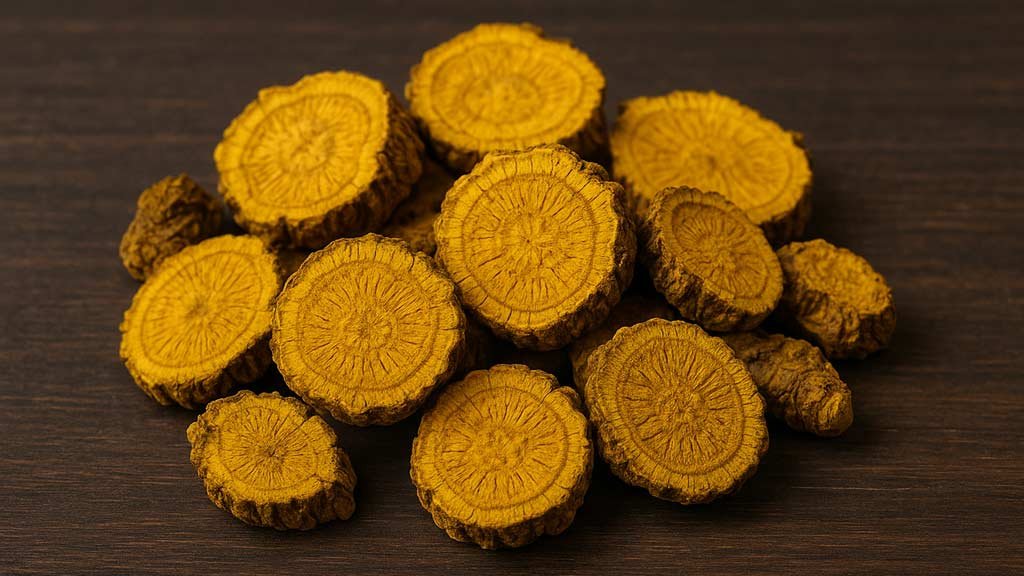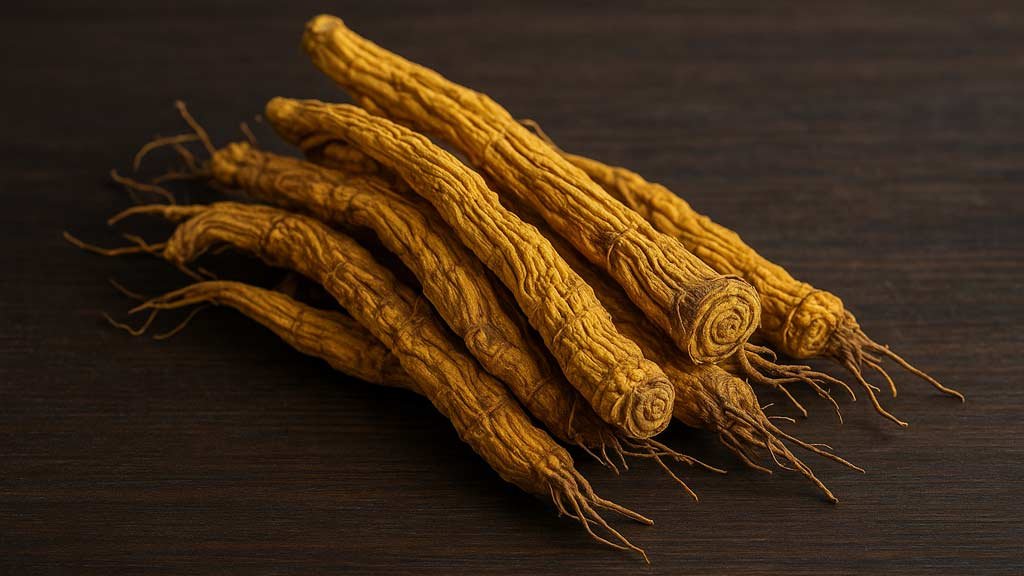The Ancient Wisdom of Coptis Root
Coptis root, often called Huang Lian in traditional Chinese medicine, has been quietly working behind the scenes of herbal remedies for centuries. This slender, fibrous root, with its golden-yellow interior, is packed with compounds that modern science has just started to appreciate. Its most celebrated ingredient? Berberine, a naturally occurring alkaloid that has been linked to numerous health benefits.
If you’ve ever wondered why traditional herbalists value bitter roots so highly, Coptis root offers a perfect example. It has a striking bitterness that almost makes you wince at first taste, but that very bitterness is a signal of its potent therapeutic properties. Think of it as nature’s warning: “Handle me with respect, and I’ll work wonders.”
Table of Contents
The Chemistry Behind the Magic
Berberine is the crown jewel of Coptis root. Chemically, it’s an isoquinoline alkaloid that has been shown in studies to:
- Modulate gut microbiota.
- Support healthy blood sugar levels.
- Provide antimicrobial action against bacteria, fungi, and some viruses.
Aside from berberine, Coptis root contains other alkaloids like coptisine, palmatine, and magnoflorine. Together, they create a synergistic effect, enhancing the root’s impact on digestive and immune health. The vibrant yellow hue of the root is a visual clue to these compounds, often used historically in dyes and medicinal concoctions.
Coptis Root and Digestive Health
For anyone battling occasional bloating, indigestion, or a sluggish gut, Coptis root can be a quiet ally. In traditional medicine, it’s often recommended for “clearing heat” in the digestive tract—a phrase that translates loosely to modern concepts of reducing inflammation and microbial imbalance in the gut.
Studies have observed that berberine can help:
- Reduce gastrointestinal inflammation.
- Support the growth of beneficial bacteria while inhibiting pathogenic strains.
- Aid in regulating bowel movements.
Imagine sipping a warm herbal decoction and feeling the tight, uncomfortable knots in your stomach slowly relax. That’s part of what makes Coptis root more than just a bitter-tasting herbal curiosity.
Using Coptis Root for Digestion
It’s traditionally consumed as a tea or decoction, often combined with other herbs to moderate its strong bitterness. Here’s a simple approach:
- Slice the dried root thinly.
- Boil gently in water for 10-15 minutes.
- Optionally, mix with a milder herb like licorice root to soften the taste.
Even a small dose can be impactful. A few sips can start to soothe an irritable stomach, particularly when digestive upset is linked to inflammation or infection.
Strengthening Immunity Naturally
Beyond the gut, Coptis root plays an intriguing role in immunity. Berberine is known to modulate immune responses by influencing cytokine production. This means it can potentially help the body manage inflammation more effectively.
Research suggests berberine can:
- Support immune cell function.
- Enhance the body’s natural antimicrobial defenses.
- Help manage chronic low-grade inflammation.
Think of it as a behind-the-scenes coach, gently nudging your immune system to respond appropriately without overreacting. It’s subtle, not aggressive—a quality that sets Coptis root apart from many conventional remedies.

Practical Applications and Recipes
Coptis root is versatile but should be respected for its potency. Here are some practical ways to include it in your wellness routine:
- Herbal Tea: As mentioned, a decoction is the most common approach.
- Tinctures: Extracted in alcohol for long-term storage and concentrated doses.
- Powdered Form: Can be mixed into capsules or sprinkled into other herbal blends.
A sensory note: the aroma is earthy, slightly musty, and unmistakably herbal. The taste? Bitter, yes, but with a lingering warmth that reminds you it’s working internally.
Precautions and Considerations
While Coptis root is generally considered safe in traditional doses, it’s not something to overdo. The bitterness signals potency, and too much can cause nausea or digestive upset. Pregnant women, nursing mothers, and individuals on certain medications should consult a healthcare provider before use. Berberine, for instance, can interact with drugs metabolized by the liver.
It’s worth noting that quality matters. Dried roots from reputable sources ensure you get the authentic Huang Lian, rich in active compounds. Adulterated or low-quality roots can reduce effectiveness and introduce unwanted contaminants.
Anecdotes and Real-Life Experiences
I remember a friend who struggled with frequent indigestion. She started using a small decoction of Coptis root, mixing it with a hint of licorice. Within a few weeks, she noticed fewer bloating episodes and a more stable digestive rhythm. She described the experience as “gentle but noticeable,” a phrase that captures the subtle yet consistent power of this root.
Another story involves a colleague who battled seasonal infections. After including Coptis root tincture in her regimen, she reported feeling “less run-down” and experiencing fewer sick days. While anecdotal, these accounts mirror findings from preliminary research, where berberine supports both gut and immune health.
Coptis Root in Modern Research
Modern science is catching up with centuries of traditional use. Clinical studies have explored berberine’s effects on metabolic health, gut microbiota, and inflammation. While more research is needed to fully map out its potential, early results are promising.
- Blood Sugar Regulation: Berberine has been shown to support glucose metabolism, making Coptis root interesting for metabolic wellness.
- Gut Microbiome: It may help maintain a balanced microbial community, indirectly influencing immune function.
- Anti-Inflammatory Effects: By modulating cytokine activity, it can help manage chronic inflammation without the side effects of long-term NSAID use.
It’s exciting to see how an ancient root can intersect with modern science, validating its long-standing reputation in traditional medicine.
Pairing Coptis Root with Other Herbs
Traditionally, Coptis root is rarely used alone. It pairs well with:
- Scutellaria baicalensis (Huang Qin): Enhances antimicrobial and anti-inflammatory effects.
- Phellodendron amurense (Huang Bai): Complements Coptis in clearing “damp heat” from the digestive and urinary systems.
- Licorice Root: Softens bitterness and harmonizes the formula.
These combinations reflect centuries of empirical wisdom, balancing efficacy with palatability.
Sourcing and Storing Coptis Root
Authenticity and freshness are crucial. When sourcing:
- Look for bright yellow interior color, firm texture, and minimal odor aside from herbal earthiness.
- Avoid roots that are overly dry, brittle, or have an off smell.
- Store in airtight containers, away from moisture and direct sunlight, to preserve active compounds.
A small tip: some traditionalists prefer to lightly roast the root before storage, which can slightly mellow bitterness without compromising potency.
Concluding Thoughts on Coptis Root
Coptis root is a treasure of traditional herbal medicine. It offers potent digestive support, immune modulation, and a taste of history that you can actually sip and feel. The combination of berberine, other alkaloids, and centuries of traditional knowledge creates a compelling case for its continued use in modern wellness routines.
While it requires respect—thanks to its strong taste and potency—the benefits are tangible. For anyone seeking a natural, plant-based approach to digestive balance and immune support, Coptis root deserves serious consideration.
It’s more than just a root. It’s a bridge between ancient wisdom and modern science, bitter yet brimming with life-changing potential.
Article Sources
At AncientHerbsWisdom, our content relies on reputable sources, including peer-reviewed studies, to substantiate the information presented in our articles. Our primary objective is to ensure our content is thoroughly fact-checked, maintaining a commitment to accuracy, reliability, and trustworthiness.
- Kong, W. J., Wei, J., Zuo, Z. Y., Wang, Y. M., Song, D. Q., You, X. F., … & Jiang, J. D. (2004). Berberine is a novel cholesterol-lowering drug working through a unique mechanism distinct from statins. Nature Medicine, 10(12), 1344–1351. https://www.nature.com/articles/nm1135
- Zhang, Y., Li, X., Zou, D., Liu, W., Yang, J., Zhu, N., … & Wang, W. (2010). Treatment of type 2 diabetes and dyslipidemia with the natural plant alkaloid berberine. Journal of Clinical Endocrinology & Metabolism, 95(12), 5589–5597. https://academic.oup.com/jcem/article/95/12/5589/2833560
- Imenshahidi, M., & Hosseinzadeh, H. (2016). Berberine and barberry (Berberis vulgaris): A clinical review. Phytotherapy Research, 30(11), 1745–1764. https://onlinelibrary.wiley.com/doi/full/10.1002/ptr.5647
- Pal, A., & Mahajan, S. (2017). Berberine: A natural plant alkaloid with promising therapeutic potential. Asian Pacific Journal of Tropical Biomedicine, 7(3), 207–212. https://www.sciencedirect.com/science/article/pii/S2221169117300333
- Chen, W., Miao, H., & Fu, W. (2015). Effects of berberine on gut microbiota and gut health. World Journal of Gastroenterology, 21(48), 14805–14815. https://www.wjgnet.com/1007-9327/full/v21/i48/14805.htm

